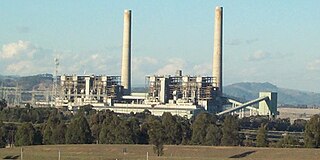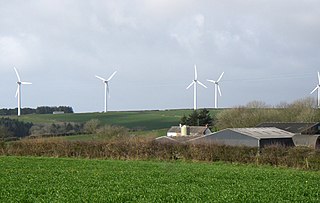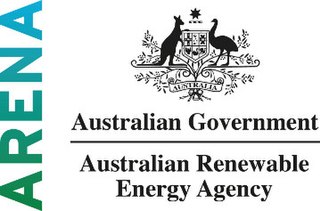
The AES Corporation is an American utility and power generation company. It owns and operates power plants, which it uses to generate and sell electricity to end users and intermediaries like utilities and industrial facilities. AES is headquartered in Arlington, Virginia, and is one of the world's leading power companies, generating and distributing electric power in 15 countries and employing 10,500 people worldwide. AES Corporation is a global Fortune 500 power company. AES Ranks in the Top Ten of Fast Company's 2022 Best Workplaces for Innovators.

Liddell Power Station is a decommissioned coal-fired thermal power station that had four 500 megawatts (670,000 hp) EE steam-driven turbine alternators, providing a combined electrical capacity of 2,000 megawatts (2,700,000 hp).

Callide Power Station is an electricity generator at Mount Murchison, Shire of Banana, Queensland, Australia. It is coal powered with eight steam turbines with a combined generation capacity of 1,720 megawatts (MW) of electricity. Callide A was commissioned in 1965, refurbished in 1998 and decommissioned in 2015/16. As of 2018, generation capacity was 1510 MW.
Collinsville Power Station is located in Collinsville, Whitsunday Region, Queensland, Australia. It had five coal powered steam turbines with a combined generation capacity of 190 MW of electricity. The coal-fired power station closed in 2013. A solar power farm generating 42MW has been built on adjacent land.

Renewable energy in Australia is mainly based on biomass, solar, wind, and hydro generation. Over a third of electricity is generated from renewables, and is increasing, with a target to phase out coal power before 2040. Wind energy and rooftop solar have particularly grown since 2010. The growth has been stimulated by government energy policy in order to limit the rate of climate change in Australia that has been brought about by the use of fossil fuels. Pros and cons of various types of renewable energy are being investigated, and more recently there have been trials of green hydrogen and wave power.

Renewable energy in the United Kingdom contributes to production for electricity, heat, and transport.

The Solana Generating Station is a solar power plant near Gila Bend, Arizona, about 70 miles (110 km) southwest of Phoenix. It was completed in 2013. When commissioned, it was the largest parabolic trough plant in the world, and the first U.S. solar plant with molten salt thermal energy storage. Built by the Spanish company Abengoa Solar, the project can produce up to 280 megawatts (MW) gross, supplied by two 140 MW gross (125 MW net) steam turbine generators: enough electricity to meet the needs of approximately 70,000 homes and obviate the emission of roughly 475,000 tons of CO2 every year. Its name is the Spanish term for "sunny spot".

Queensland's energy policy is based on the year 2000 document called the Queensland Energy Policy: A Cleaner Energy Strategy. The Queensland Government assists energy development through the Department of Energy and Water Supply. The state is noted for its significant contribution to coal mining in Australia. The primary fuel for electricity generation in the state is coal with coal seam gas becoming a significant fuel source. Queensland has 98% of Australia's reserves of coal seam gas. An expansion of energy-intensive industries such as mining, economic growth and population growth have created increased demand for energy in Queensland.
Carbon capture and storage (CCS) is a technology that can capture carbon dioxide CO2 emissions produced from fossil fuels in electricity, industrial processes which prevents CO2 from entering the atmosphere. Carbon capture and storage is also used to sequester CO2 filtered out of natural gas from certain natural gas fields. While typically the CO2 has no value after being stored, Enhanced Oil Recovery uses CO2 to increase yield from declining oil fields.

CS Energy is an Australia-based electricity generating company fully owned by the Government of Queensland with its head office located in Fortitude Valley, Brisbane. The company was established in 1997 and employs more than 500 staff. Adam Aspinall is the Board Chair and Darren Busine is the Chief Executive Officer.
Australia is well placed to harness solar thermal energy. Solar thermal energy is used in three main ways: solar hot water heating, production of steam for electricity generation and space heating through building design.
Different methods of electricity generation can incur a variety of different costs, which can be divided into three general categories: 1) wholesale costs, or all costs paid by utilities associated with acquiring and distributing electricity to consumers, 2) retail costs paid by consumers, and 3) external costs, or externalities, imposed on society.

Braemar Power Station is a complex of natural gas and coal seam gas fired combined-cycle power stations in Kogan, Western Downs Region, Queensland, Australia. It is near Dalby in the Darling Downs region.
Areva Solar was part of the renewable energies portfolio of the French nuclear group Areva, headquartered in Mountain View, California, with offices in the United States and Australia. It designed, manufactured and installed solar steam generators for electric power production and industrial steam uses. Before 2010, the company existed as Ausra Inc. In August 2014, AREVA announced it was shuttering AREVA Solar.
South Australia is a leader in utility-scale renewable energy generation, and also produces gas and uranium for electricity generation. Gas production is mostly concentrated in the Cooper Basin in the state's north-east. Gas is delivered from these fields by pipeline to users interstate and to Port Adelaide where it fuels three separate gas-fired power plants. Uranium is also mined in South Australia, though nuclear power generation is prohibited nationally. The Olympic Dam mine is the world's single largest known deposit of uranium and represents 30% of the world's total uranium resource. Many utility-scale wind farms and solar farms have been commissioned during the 21st century and geology with potential for geothermal energy has also been identified but is yet to be developed.

The Australian Renewable Energy Agency (ARENA) is an independent agency of the Australian federal government, established in 2012 to manage Australia's renewable energy programs, with the objective of increasing supply and competitiveness of Australian renewable energy sources.

The electricity sector in Australia has been historically dominated by coal-fired power stations, but renewables are forming a rapidly growing fraction of supply. In 2021, Australia's electricity production reached 265 TWh, with coal accounting for 52.9% and natural gas for 18.8%. Renewable sources, comprising solar, wind, hydro, and bioenergy with waste, collectively made up 26.7% of the total electricity generation mix.
Shell Energy Australia provides gas, electricity, environmental products and energy productivity services to commercial and industrial customers.
CleanCo Queensland is a Queensland Government-owned corporation. CleanCo own and operate a range of electricity generation assets in Queensland, consisting of run-of-the-river hydroelectricity, pumped-storage hydroelectricity, gas-fired generation, grid-scale solar and wind power generation. Queensland has a plan to generate 50% of its electricity from renewables sources by 2030. CleanCo was established in 2018.












